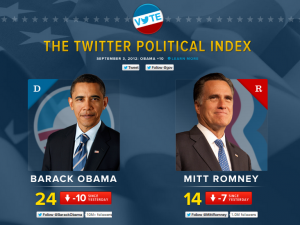It is a presidential election year and a lot has changed in digital communications technologies in the four short years since our last presidential election. Both campaigns are using these tools, going to the channels where their voters are talking and joining in the conversation, though their approaches are slightly different. Using these digital channels, voters get to know their candidates better, ask questions directly and really break down the barriers of communication with candidates to dig into the information they need and want to know to make a decision for our country’s highest elected position.
How are the presidential campaigns using digital tools?
Both Romney and Obama are using digital tools to talk directly with voters and bypassing the filter of the media. Facebook, Twitter, Tumblr, Flickr, YouTube, Reddit, blogs, Instagram, Spotify, Pinterest, Google+, LinkedIn, Foursquare – you name a channel or platform and one, if not both, of the campaigns is using it in some way.
When comparing the two for frequency of content distribution, we see that the Obama campaign is posting nearly four times as much content as the Romney campaign, and is active on nearly twice as many platforms. According to recent research, the ”Obama’s digital content also engendered more response from the public [with] twice the number of shares, views and comments of his posts.” However, the Romney campaign their approach is about quality over quantity and as a result, they are seeing a higher engagement from their fans and followers than the Obama team is seeing.
Here is a nice video summary of the accounts and activity by each campaign:
But neither are really very “social.”
Voter-contributed content is only minimally present in Romney’s digital channels. The Obama campaign has made only a slightly better use of citizen voices, but only on the “news blog” on its website where that content could be completely controlled. The Obama campaign has also localized its digital messaging significantly, adding state-by-state content pages filled with local information. Neither candidate is engaging in conversation, however: rarely did either candidate reply to, comment on, or “retweet” something from a citizen-or anyone else outside the campaign.
Though when the candidate is involved in a live situation, they really are having the conversations. Both candidates have used Google+ Hangouts to have conversations with voters. And very recently, Obama did an AMA (ask me anything) session on Reddit. There was so much activity on Reddit for the 30 minutes that Obama was answering questions live that the site crashed several times. This type of conversation has never been done before with a presidential candidate and though it was announced voters quickly learned about it through social media and jumped at the chance to talk to the President.
Big news and events spur conversations.
The announcement of Paul Ryan as Romney’s running mate spurred some energy into the Romney digital channels. On the announcement day nearly 4,000 tweets per minute about Ryan were sent during the event. The announcement drove mentions of Romney over those of Obama for the first time in three months. It pushed Romney’s Facebook page over the 4 million mark and more than 1.5 million people were “talking about” him on the social network: an engagement rate of roughly 37%. While Obama’s “likes” count is around 28 millon, he has less than a half-million users “talking about” his page: an engagement rate of less than 5%.
And when Ann Romney spoke at the GOP convention, she was the most searched speaker of the night on Twitter and Google.
For a real time view of how voters are feeling and for a glimpse at what is driving the conversation, the Twitter Political Index is tracking–on a daily basis–the sentiment around each candidate expressed through tweets about the campaign. It reported that the Clint Eastwood performance with a chair spurred much conversation the last night of the RNC. The Obama campaign responded with a tweet that became the most retweeted tweet of the RNC.
The conventions.
The Republican National Convention went full force with employing digital communications channels. They called their convention “‘the convention without walls,’ because they wanted to proclaim that people anywhere in the country can feel like they are a part of it, feel like they are there.” The RNC even created a custom YouTube page in addition to hiring social media reporters to be on the floor at the convention updating the various platforms.
The Democratic National Convention launches this week. The DNC is also aiming to make their convention an open experience. ”Our goal for this convention is to make it the most open and accessible convention in history,” Nikki Sutton, Democratic National Convention Committee director of digital media, told CBS News in an emailed statement. “From the very beginning we’ve used social media as a tool to have a conversation with Americans from all over the country. Between our use of social media and our opening and closing public events, this convention will include more people than ever before.”
What’s next?
From both candidates, as we get closer to the election day, we will probably see more of-the-moment, unannounced live events similar to Obama’s Redditt AMA, plus more outreach for personal conversations and direct interactions to sway voters to one side or the other.
Check out this info graphic for stats on the role social media plays in the decisions of voters.


